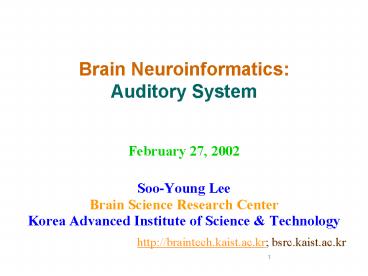Brain Neuroinformatics: Auditory System PowerPoint PPT Presentation
1 / 29
Title: Brain Neuroinformatics: Auditory System
1
Brain NeuroinformaticsAuditory System
- February 27, 2002
- Soo-Young Lee
- Brain Science Research Center
- Korea Advanced Institute of Science Technology
- http//braintech.kaist.ac.kr bsrc.kaist.ac.kr
2
Artificial Auditory System
- Based on Human Cognitive Mechanism
- Develop mathematical model and auditory chip
- Develop Continuous speech recognition system
3
Auditory Pathway
- ? Improvement of Cochlea model
- Binaural hearing model
- Auditory cortex model
- Selective attention model
- Continuous-speech recognition system
- Speech-recognition chip
4
Research Scopes
Auditory Pathway
5
Masking
- Lateral Inhibition
- Recursive
6
Masking using Lateral Inhibition
7
Temporal Masking
8
Temporal Masking Integration Model
9
Time Frequency Response
10
Isolated Word Recognition Rates
11
Discussions Masking
- Masking Suppresses Unwanted Noisy Components in
Signal - Simultaneous Masking by Lateral Inhibition
- - Recognition performance was enhanced with
MFCC model - - Proposed model can be used with any
auditory model - - ZCPA has spectral masking effect
- Temporal Masking by Unilateral Inhibition
- - Unilateral inhibition using the integration
model - - Model resembles other feature processing
algorithms - - Recognition performance was enhanced with
RASTA parameters
12
Channel Compensation
- ASR in mismatched environments
- Environmental information
- Background noise, acoustic/transmission channel
- Assume environment degradation model
13
Speaker-to-Microphone mapping
- Mapper train
- Where and which type of mapper should be
deployed?
14
Adaptive Noise Cancelling
- Adaptive noise cancelling
- An approach to reduce noise based on reference
noise signals - System output
- The LMS algorithm
15
ICA-based Approach to ANC
- The difference between the LMS algorithm and the
ICA-based approach - Existence of the score function
- The LMS algorithm
- Decorrelate output signal from the reference
input - The ICA-based approach
- Make output signal independent of the reference
input - Independence
- Involve higher-order statistics including
correlation - The ICA-based approach
- Remove the noise components using higher-order
statistics and correlation
16
TDAF approach to ANC
- Normalized LMS algorithm
- Normalized ICA-based algorithm
where
where
17
Experimental Results (1)
- Experiments for artificially generated i.i.d.
signals - SNRs of output signals for the simple simulation
mixing filter (dB)
18
Experimental Results (2)
- Experiments for recorded signals
- Signal waveforms for the car noise and the simple
simulation filter
Signal source
Noise source
Primary input signal
System output signal
19
Experimental Results (3)
- Experiments for recorded signals
- SNRs of output signals for the measured filter
20
Experimental Results (4)
- Comparison of learning curves with and without
TDAF - Car noise
The ICA-based approach
The LMS algorithm
21
Discussion ANC
- A method to ANC based on ICA was proposed.
- The ICA-based learning rule was derived.
- The ICA-based approach
- Include higher-order statistics
- Make the output independent of the reference
input - The LMS algorithm
- Make the output uncorrelated to the reference
input - Gave better performances than the LMS algorithm
- TDAF method was applied to the ICA-based
approach. - Derived the normalized ICA-based learning rule
- Improved convergence rates
22
Bottom-Up and Top-Down Attention
External Cue
Internal Cue
Attended Output
Classifier Output
- Bottom-Up
- - Masking
- - ICA
- Top-Down
- - MLP
- - HMM
Bottom-Up Recognition
Top-Down Expectation
Attended Input
Bottom-Up Attention
Input Features
Brain
Environment
Input Stimulus
23
??? ?? ?? ????(1)
- ??? ?? ?? ????
- ??8051???? ??(???)
- 12 MHz ?? 1.93 MIPS
- ???? ?? ??(16??)
- ?? ??? ?? ?? ???
- 50 ?? ? 20 ms ?? ?? ?? ??
- ??? 95 ??
24
??? ?? ?? ????(2)
- Hynix 0.35 ??
- ??? ?? 64-TQFP
- ?? ??? 128x12, 256x8, 2048x8
- AGC, A/D, D/A ??
- 12KHz, 12 bit A/D
- 12Khz, 8 bit D/A
- ??? ?? ?? ????
- ?? ?? ????
- ?? ?? ????
- ??? ?? ???? ??
25
??? ?? ?? ????(3)
- CM8051 ??? ? I/O ???
26
??? ?? ?? ????(4)
- ?? ?? ???
27
Analogue ICA Chip
- ? ? multiplier
- ? ? current summation
- r ? learning rate
4 x 4 ICA network in one Chip
28
Test Results in Waveforms
- Source Signals (s1, s2)
- two different males voice
- 16 kHz sampled
- Mixed Signals (x1, x2)
- Instantaneous mixture
- Mixing Mtx A is
- Separated Signals (o1, o2)
- Recovered original sources
29
Fabricated Chip
- 2.8mm x 2.8mm
- AMS CMOS 0.6um
- 2 poly-3 metal
- Analog Digital Hybrid Process
Die Photo of a Fabricated ICA Chip

